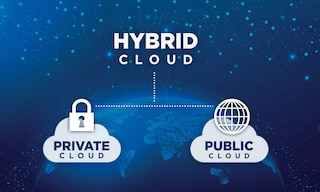
Hybrid cloud: the best of public and private clouds
The hybrid cloud strategy is one of the most common in IT today. Hybrid cloud computing is becoming increasingly widespread, and almost no one relies exclusively on a public cloud anymore. But what exactly is this concept?
Hybrid cloud: What is it?
Hybrid cloud refers to solutions with applications or components deployed across both public and private clouds. A hybrid cloud is a cloud computing environment that uses a combination of local, private-cloud, and third-party public cloud platforms. Typically, it involves a connection from an on-premise or local data center to a public cloud that may also employ other resources such as edge AI devices or cloud storage.
Hybrid cloud examples
There is no one-size-fits-all hybrid cloud configuration. Instead, businesses can choose the option that best suits their particular needs.
For example, a hybrid cloud can consist of a public and a private cloud running on-premises (on company servers). It can also integrate two public clouds, known as a multi-cloud model. The most popular hybrid cloud scenario involves connecting a public cloud with an on-premise private cloud.
Similarly, a hybrid cloud can be applied in cloud logistics, i.e., to control operations that take place inside and outside the facility. Businesses in this sector use programs such as warehouse management systems (WMSs) to expedite and fine-tune their processes.
Advantages of hybrid cloud
By investing in a hybrid cloud solution, you’ll avoid having to purchase, install, and maintain new servers you might not need in the long term. This solution also provides other benefits:
- Effective application control. Being able to decide where to host an application and where to run hybrid computing operations gives you greater control. It enhances privacy and ensures compliance with requirements.
- Flexible operations. Hybrid cloud lets you use the most suitable environment for each need.
- Faster innovation. This model provides access to the latest technologies — e.g., artificial intelligence and machine learning — without having to expand or replace the existing infrastructure.
- Higher return on investment. Incorporating a public cloud service provider into an on-premise system extends cloud computing capabilities without driving up data center expenses.
- Improved performance and lower latency. The hybrid cloud model can benefit applications hosted in remote locations. Likewise, programs requiring lower latency can be run close to end users.

How does hybrid cloud storage work?
Hybrid clouds combine the resources and services of several independent computing environments. Therefore, they call for integration and coordination to share and sync information in an agile manner. To operate correctly, the hybrid cloud infrastructure requires a network normally comprising the following elements:
- Application programming interfaces (APIs). Sets of rules and protocols that allow different applications to communicate with each other.
- Local area network (LAN). A computer network that spans a limited geographical area, such as a home, office, or university campus.
- Wide area network (WAN). A communication network that covers an extensive geographical area, usually a country, a continent, or even globally.
- Virtual private network (VPN). Technology that establishes a secure, encrypted connection between two points over a public network, such as the internet.
Why would a company use hybrid cloud?
Hybrid cloud solutions offer advantages in multiple circumstances:
- Digital transformation. Sometimes companies can’t modernize their infrastructure through public clouds because certain legacy applications compel them to maintain a private data center. The hybrid model allows for a mixed approach.
- Development and testing. Testing on public clouds is cheaper, as you don’t have to purchase or configure hardware. Hybrid clouds are ideal for these development projects.
- IT resource expansion. Hybrid clouds can increase the capacity of private networks through cloud bursting. This configuration allows private clouds to access resources from the public cloud. They can even become part of it temporarily during demand spikes.
- Backup and recovery. Local information can be replicated and safeguarded through backups in the hybrid cloud. This way, if the data center experiences an interruption, work can continue to be carried out via the cloud.
- Edge computing. Utilizing edge computing in hybrid clouds enables businesses to perform labor-intensive tasks involving sensitive data closer to their source. This reduces latency and enhances protection.
- Application migration. Migrating elements to the cloud at your own pace lets you transform your technical infrastructure gradually.

Benefits of hybrid cloud in intralogistics processes
The cloud and process automation are major allies for companies’ logistics operations:
- Increased efficiency. Cloud computing facilitates the operation of programs such as a WMS. This software is extremely useful for logistics managers in maintaining control over operations.
- Improved customer service. Better supply chain visibility ensures more accurate estimated delivery dates, enhancing the consumer experience.
- Cost reductions. Hybrid clouds can avoid hardware purchases and make route management more effective, resulting in cost savings.
- Greater agility. Thanks to software like WMSs, logistics managers can pivot quickly to market changes.
SaaS WMS
If you want to manage your logistics processes more efficiently while leveraging new technologies, be sure to contact us. Interlake Mecalux’s Easy WMS was developed by a team of 400 engineers and is supported by a company with over 55 years of experience in the intralogistics sector.
This tool controls operations in automated and manual warehouses, offering multiple advantages and two architecture options. In the software as a service (SaaS) model, Easy WMS is hosted in the cloud. With the on-premise architecture, both the software and hardware are located in the client’s facility. Together, we’ll find the solution that best suits your business needs.
